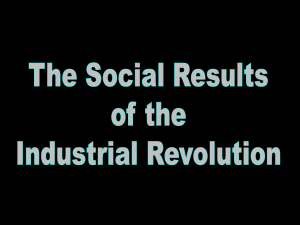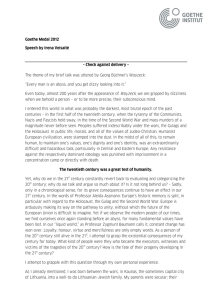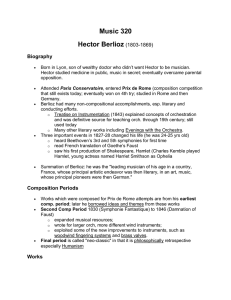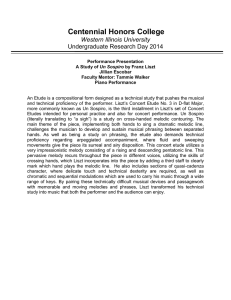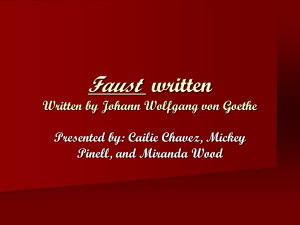FAUST 19 CENTURY ORCHESTRAL MUSIC LA FAUST SYMPHONY (1856)
advertisement
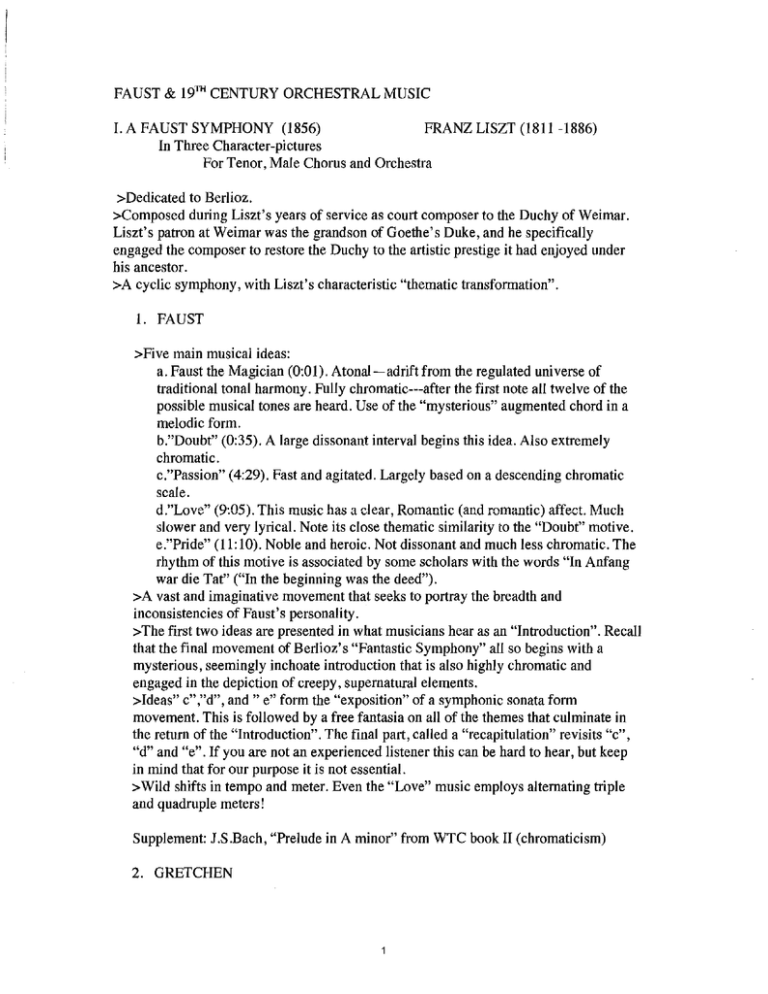
FAUST & 19TH CENTURY ORCHESTRAL MUSIC LA FAUST SYMPHONY (1856) FRANZ LISZT (1811 -1886) In Three Character-pictures For Tenor, Male Chorus and Orchestra >Dedicated to Berlioz. >Composed during Liszt's years of service as court composer to the Duchy of Weimar. Liszt's patron at Weimar was the grandson of Goethe's Duke, and he specifically engaged the composer to restore the Duchy to the artistic prestige it had enjoyed under his ancestor. >A cyclic symphony, with Liszt's characteristic "thematic transformation". I. FAUST >Five main musical ideas: a. Faust the Magician (0:01). Atonal -adrift from the regulated universe of traditional tonal harmony. Fully chromatic---after the first note all twelve of the possible musical tones are heard. Use of the "mysterious" augmented chord in a melodic form. b."Doubt" (0:35). A large dissonant interval begins this idea. Also extremely chromatic. c."Passion" (4:29). Fast and agitated. Largely based on a descending chromatic scale. d."Love" (9:05). This music has a clear, Romantic (and romantic) affect. Much slower and very lyrical. Note its close thematic similarity to the "Doubt" motive. e."Pride" (11: 10). Noble and heroic. Not dissonant and much less chromatic. The rhythm of this motive is associated by some scholars with the words "In Anfang war die Tat" ("In the beginning was the deed"). >A vast and imaginative movement that seeks to portray the breadth and inconsistencies of Faust's personality. >The first two ideas are presented in what musicians hear as an "Introduction". Recall that the final movement of Berlioz's "Fantastic Symphony" all so begins with a mysterious, seemingly inchoate introduction that is also highly chromatic and engaged in the depiction of creepy, supernatural elements. >Ideas" COO ,"d", and" e" form the "exposition" of a symphonic sonata form movement. This is followed by a free fantasia on all of the themes that culminate in the return of the "Introduction". The final part, called a "recapitulation" revisits "c", "d" and "e". If you are not an experienced listener this can be hard to hear, but keep in mind that for our purpose it is not essential. > Wild shifts in tempo and meter. Even the "Love" music employs alternating triple and quadruple meters! Supplement: J.s.Bach, "Prelude in A minor" from WTC book II (chromaticism) 2. GRETCHEN 1 >Though very rich harmonically, this movement is much less chromatic in general than those that surround it. >A vast ABA form. >A brief and fragile sounding introduction for flutes and clarinets. >The "A" section is made up of two themes for Gretchen. The first is a lyrical oboe solo accompanied by the murmuring "spinning" of the violas (1:16). A brief transition famously illustrates the plucked flower petals of "he loves me, he loves me not" (4:27). The second is closely related, but is notable for a more chordal texture (6:51). Perhaps this homophonic texture suggests church music and prayer. There is a more dramatic middle section- "B" (9:03)-- in which Faust's themes appear more and more insistently and which culminates in his song of seduction. The "A" section, much altered, returns (15: 12). Note just before the end an isolated fragment that sounds like a lullaby (21:15). Is Liszt delicately hinting at Gretchen's pregnancy? Supplement: Franz Schubert, "Gretchen am Spinnrade" (a musical depiction of the spinning wheel) 3. MEPHISTOPHELES >As Mephisto is the "spirit of negation" he has no musical "themes" of his own, but is rather depicted through ideas that are parodistic deformations of Faust's themes. >Again there is an introduction, and again its focus on the grotesque invites comparison to the last movement of the Berlioz. The movement proper begins at (1;15). >Most of the music is dance-like. Clearly Liszt is composing a vast witche's orgy, a vast Walpurgis Night. >The form is quite free, though elements of sonata form are present, but the effect is that is is freely composed. >Note grotesque, brutal and highly chromatic fugue that is based mostly on the "Doubt" theme (4:15). Like the fugue in Berlioz this too suggests a blasphemous revision of a style associated with sacred music. It also as the most complex and arcane of music styles, and evokes the Faust-like "magic" of old Bach. >Climactic reappearance of the first "Gretchen" theme from the second movement (8:29). Note that it cannot be deformed. Mephisto tries to draw Faust back into the orgy, but he resists and will insist of rescuing Gretchen. As the intensity subsides only fragments of "Gretchen" music remain---surely this is Liszt's equivalent to the prison scene (13: 12). Musically there is a clear sense of catastrophe, and the grotesque theme seems to pull at the Magic/Faust theme is such away that one can imagine Mephisto's panic as he tries to persuade Faust to abandon the cell. Does the orchestra suggest the announcement of Gretchen's salvation with the slow descending scales representing the roses that fall from heaven? Originally in 1853 Liszt ended the movement with a triumphant presentation of the "Pride" theme. >In 1856 Liszt added the final section (16: 11). This is music of enormous expansiveness; so slow in it's unfolding that the listener loses all sense of time. The male chorus and solo tenor sing the final line of Goethe's poem as the music gradually becomes ever more ethereal. 2 Supplement: J.S .Bach, "Fugue in G minor" from WTC book I (exposition only; a clear easy-to-hear example of Fugue) "All things transitory are but parable; here insufficiency becomes fulfillment, here the indescribable is accomplished; the eternal feminine draws us heavenward." "Alles Vergangliche 1st nur ein Gleichnis; Das Unzulangliche Hier wird's Ereignis; Das Unbeschreibliche Hier ist's getan; Das Ewig-Weibliche Zieht uns hinan." Goethe, Faust Part II, final lines II.ALSO SPRACH ZARATHUSTRA (1896) RICHARD STRAUSS (1864-1949) Tone Poem for large orchestra after F.W.Nietsche >The opening section has in recent years become one of the most famous passages in the repertoire. It is designed to depict the rising of the sun. Note the almost total lack of chromaticism and the very limited use of dissonance in general. >the section we will briefly explore is labeled in the score as "Science". It is a fugue, and like the first of the "Faust" themes in Liszt's symphony it uses all twelve of the musical notes. >In the end it is entirely unsatisfactory. This is exactly Nietzsche's and Strauss's point. PAUL DUKAS (1865-1935) III. L'APPRENTI SORCIER (1897) Scherzo d' apres use ballade de Goethe) >Based on another poem by Goethe, this time a comic one. >After an introduction, the piece employs a fairly straightforward ABA form. >Note the prominent use of our friend the augmented triad, now used in a harmonic form. >Enjoy the Mouse! 3 MIT OpenCourseWare http://ocw.mit.edu 21M.013J / 21A.113J / 21L.013J The Supernatural in Music, Literature and Culture Fall 2013 For information about citing these materials or our Terms of Use, visit: http://ocw.mit.edu/terms.


